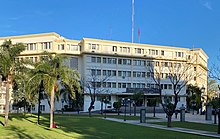Tangier International Zone
[2] For nearly a century after the end of English rule in 1684, Tangier was primarily a military town, the main fortified outpost on the Moroccan Sultanate's side of the Strait of Gibraltar.[7]: 360 In 1840, a Dahir (decree) of Sultan Abd al-Rahman mandated them to establish a Sanitary Council (French: conseil sanitaire),[8]: 306 chaired by the envoys of the represented nations on a rotating basis in the name of the Makhzen.[10]: 272 In 1887, Greek-American community leader Ion Hanford Perdicaris advocated a special status for Tangier as a neutral free port under the great powers' joint control.That same year, a secret treaty between France and Spain acknowledged Tangier's special status and thus marked the first official prefiguration of later formal international arrangements.[3]: 119 The Act of Algeciras also resulted in the creation of a dual police force under foreign control, the Tabor divided between French and Spanish components,[3]: 236 respectively in charge of public order outside and inside the city limits.[1]: 17 [7]: 363 Meanwhile, Tangier still operated under an ad hoc governance regime with a Sultan-appointed governor, the Naib reduced to a largely ceremonial role since Morocco under the protectorates no longer had an autonomous foreign policy, the extraterritorial courts under the respective foreign delegations (downgraded back to consulate status for the same reason), the Sanitary Council, the Hygiene Commission, the French and Spanish Tabors, and assorted specialized committees.[7]: 361 The Paris Convention was proposed for ratification to the other powers that were party to the Algeciras Conference, except Germany, Austria and Hungary, disempowered by the peace treaties (respectively of Versailles, Saint-Germain and Trianon), and the Soviet Union, then estranged from the international system.[17]: 233 It was ratified by Belgium (on 6 December 1924),[7]: 364 Sweden, the Netherlands (on 5 October 1925), and eventually by Portugal (on 28 January 1926),[18] putting an end to an awkward early period during which the Committee of Control practically could not reach a quorum.[8]: 321 That revision also allowed the final abolition of Tangier's former ad hoc institutions, the Sanitary Council and Hygiene Commission, which Italy had previously insisted to maintain.[8]: 329 The Zone's key institutions, the Committee of Control and Legislative Assembly, were abolished on 3 November 1940,[7]: 371 triggering a diplomatic dispute between Britain and Spain that led to a further guarantee of British rights and a Spanish promise not to fortify the area.[7]: 373 It concluded with a temporary Anglo-French Agreement of 31 August 1945, in which the two powers made arrangements for the re-establishment of the Zone's international institutional framework, invited the United States and the Soviet Union to join it, and reversed the advantages that Italy had secured under the 1928 Protocol.[8]: 331 Following the end of the French protectorate on 2 March 1956 and of the Spanish one on 7 April 1956, the Committee of Control of the Tangier Zone met in June 1956 and proposed a protocol for a temporary regime, which was signed by Moroccan Foreign Minister Ahmed Balafrej on behalf of Sultan Mohammed V in Rabat on 5 July 1956.[7]: 380 Balafrej insisted that, while the abolition of the international status was a matter of negotiation with the foreign powers represented in the Committee of Control (namely Belgium, France, Italy, the Netherlands, Portugal, Spain, the UK, and the United States), the future arrangements were not and would be decided solely by the Moroccan authorities.[29] The resulting protocol signed on 29 October 1956 returned Tangier to full Moroccan sovereignty with immediate effect, while the operation of its international institutions was extended for practical purposes only until the end of 1956.[36] The assembly's membership was set as follows: 4 French, 4 Spanish, 3 British, 2 Italians (3 after 1928, 1 after 1945), 1 American (seat unoccupied until 1940,[37] 3 after 1945), 1 Belgian, 1 Dutch, 1 Portuguese, 6 Muslims, and 3 Jews.[39]: 116 Following the convention of November 1952, the renamed International Jurisdiction included 2 judges from France, 2 from Spain, and 1 from each of Belgium, Italy, Morocco, the Netherlands, Portugal, Sweden, the UK, and the U.S., as well as Spanish and French prosecutors.[28]: 516 The State Bank of Morocco, whose head office was in Tangier, remained under the jurisdiction of a special tribunal created by Article 45 of the Act of Algeciras of 7 April 1906,[28]: 516 from which appeals went to the Federal Supreme Court of Switzerland in Lausanne.The initial economic effect of the creation of the International Zone was sharply negative, because the Spanish protectorate authorities discouraged commerce with it and thus Tangier lost most of its traditional hinterland.







ArabicFrenchSpanishInternational ZoneTangierDarijaEnglishPortugueseHaketiaChristianityJudaismSpanish occupationMoroccan francSultanate of MoroccoKingdom of MoroccoSpanish occupation of Tangier (1940–1945)Spanish protectorate in MoroccoSultan of MoroccoFrench protectorateBaedekerMedinaEnglish ruleStrait of GibraltarMohammed ben AbdallahGibraltarTétouanconsul of FranceSardiniaTuscanylegationsIslamic lawMuslimsJudaic lawMakhzenRepublic of PisacapitulationsUnited Kingdom in 1856Treaty of Wad Rasprotégé systemTreaty of MadridquarantineAbd al-RahmanCape SpartelHassan IIon Hanford Perdicarisfree portgreat powersMoroccan Debt AdministrationAlgeciras ConferenceState Bank of MoroccoTreaty of FesFrench protectorate in MoroccoTreaty Between France and Spain Regarding MoroccoWorld War IconsulateFrench legationDar NiabaU.S. legationMendoubiaCannesFrancetax havenGermanyAustriaHungaryVersaillesSaint-GermainTrianonSoviet UnionSpanish troopsParis fell to the GermansRafael Sánchez MazasFrancoist StateAhmed BalafrejMohammed VFedalaMohammedia1958 Rif riotsList of rulers of the Tangier International ZoneMarshan PalaceMendoubPermanent Court of International Justicethe HagueFrench ConsulateWorld War IIMendoub's Residenceconsular courtsconsular courtFederal Supreme Court of SwitzerlandLausanneart decoPashasbohemianismoffshore financial centreFirst World WarJewishEuropean ChristiansChristiansMoroccan independenceregionTanger-Tetouan-Al HoceimaTangier SpeechMixed Courts of EgyptConcessions in ChinaFree City of CracowFree City of DanzigPanama Canal ZoneBank secrecyThe London GazetteEncyclopædia BritannicaJewish Virtual LibraryBeevor, AntonyPayne, Stanley G.Cambridge University PressForeign AffairsCouncil on Foreign RelationsStanford University PressFinlayson, IainHistory of TangierTimelineList of European governors of TangierBattle of Tangier (1664)English TangierTangier Garrison1st Tangier Regiment2nd Tangier Regiment